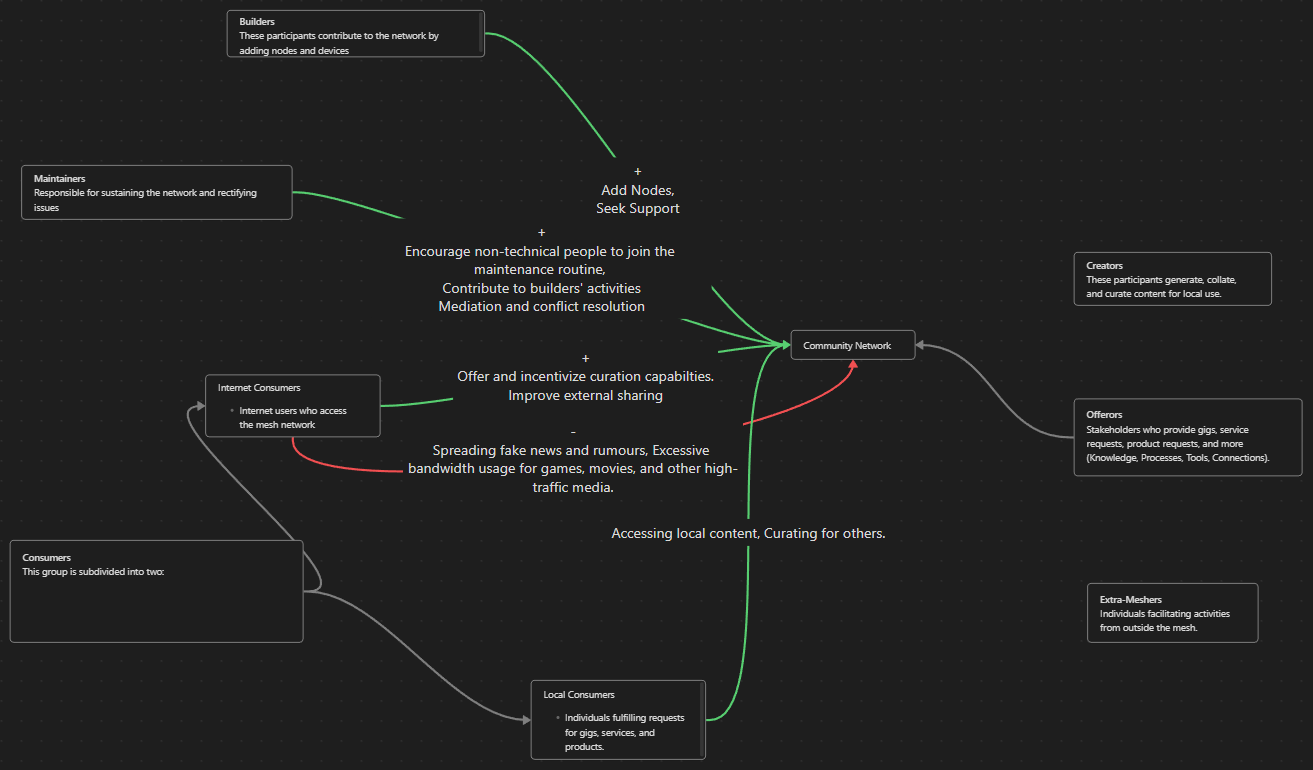Establishing a community network
in Portfolio / Research-and-writing / Writing

A speculative framework to imagine contributors to a community network
The establishment of a Generative Community-Owned (CoW) Wifi Mesh Network, focused on facilitating content creation and utilization, can spur local businesses. This article will outline the roles various stakeholders play, and explore the actions that can be encouraged or discouraged to maintain the network’s generative characteristics. See Guifi.net
- seed!
Stakeholders in the CoW Network
- Builders: These participants contribute to the network by adding nodes and devices.
- Maintainers: Responsible for sustaining the network and rectifying issues.
- Consumers: This group is subdivided into two:
- Internet users who access the mesh network
- Individuals fulfilling requests for gigs, services, and products.
- Creators: These participants generate, collate, and curate content for local use.
- Offerors: Stakeholders who provide gigs, service requests, product requests, and more (Knowledge, Processes, Tools, Connections).
- extraMeshers: Individuals facilitating activities from outside the mesh.
Optimization Actions for Each Role
- Builders
- Incentivized Actions: Addition of nodes, Seeking support.
- Maintainers
- Incentivized Actions: Encourage non-technical people to join the maintenance routine, Contribute to builders’ activities.
- Internet Consumers
- Incentivized Actions: Offer curation capabilities and incentivize it. Improve sharing capabilities outside the local network.
- Discouraged Actions: Spreading fake news and rumours, Excessive bandwidth usage for games, movies, and other high-traffic media.
- Local Content Consumers
- Incentivized Actions: Accessing local content, Curating for others.
- Associated Actions: Tied to offerors’ activities.
- Offerors
- Incentivized Actions: Creating local content, Offering local jobs, Prioritizing smaller first, Offering curation and collection, Establishing local value-adding enterprises.
- Discouraged Actions: Encouraging ad watching.
- Associated Actions: Linked to creators and local content consumers’ activities.
Key Considerations and Questions
In these categories, we explore the dynamics of interactions - what is encouraged, what is discouraged, and how different actions feed into each other. This lays the foundation, prompting further important questions:
- Should this be quantified? Why or why not?
- If it’s not quantified, can incentives be conceptualized differently, apart from currency?
- If it is currency, how should it be quantified?
Phases of the Network Life Cycle
- Preliminary Phase: This involves understanding the metastructure (value systems, stakeholders, data tagging) and designing the system (validating, redesigning).
- Operational Phase: Here, we establish rules of exchange and engagement, enable the necessary technology, and integrate necessary elements.
